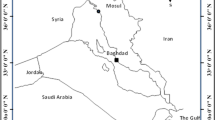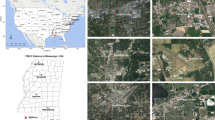Abstract
PM2.5/PM10 ratio is essential for understanding particulate pollution’s severity and adverse effects on human beings as it reveals how long the particle will stay in the atmosphere and where it will deposit in the human respiratory tract. The present study focuses on the spatio-temporal variability of the PM2.5/PM10 ratio from nine sites (six in Delhi, one each in Amritsar, Varanasi and Kolkata) in the Indo-Gangetic Plain (IGP) during the last 3 years (2019–2021) before, during, and after the COVID-19 pandemic-induced lockdown in India. Robust statistics such as median and percentiles have been employed to avoid bias due to non-normal distributions. Considerable spatial and temporal variability was seen throughout the 3 years. Amritsar and one site in Delhi exhibited the least temporal variability in PM2.5/PM10 (~ 10%) annually. However, the highest average variation over the 3 years was ~ 28%, noticed for one site in Delhi. The PM2.5/PM10 ratio was high (~ 0.6 ± 0.1) during the post-monsoon (Oct–Dec) and winter (Jan–Feb) seasons. The PM2.5/PM10 ratio was low (~ 0.4 ± 0.1) in the monsoon season (June–Sep.) and pre-monsoon season (Mar–May). Conditional Bivariate Probability Function (CBPF) and Cluster Analysis using Hysplit data were done to assess the local and long-range source of pollutants arriving at a receptor location. The impact of wind speed and relative humidity on the PM2.5/PM10 ratio was also analysed. The results of this study would help establish an intricate policy framework for cities in the IGP.











Similar content being viewed by others
Data Availability
The data used in this study were obtained from https://app.cpcbccr.com/ccr/#/caaqm-dashboard-all/caaqm-landing.
References
Abuelgasim A, Farahat A (2020) Investigations on PM10, PM2.5, and their ratio over the Emirate of Abu Dhabi, United Arab Emirates. Earth Syst Environ 4(4):763–775. https://doi.org/10.1007/s41748-020-00186-2
Air quality worse in smaller towns in Indo-Gangetic Plains compared to bigger cities, says CSE’s latest analysis. (n.d.). Retrieved April 19, 2022, from https://www.cseindia.org/air-quality-worse-in-smaller-towns-in-indo-gangetic-plains-compared-to-bigger-cities-10614
Amato F, Pandolfi M, Viana M, Querol X, Alastuey A, Moreno T (2009) Spatial and chemical patterns of PM10 in road dust deposited in urban environment. Atmos Environ 43(9):1650–1659. https://doi.org/10.1016/j.atmosenv.2008.12.009
Bates DV (1995) The effects of air pollution on children. Environ Health Perspect 103(Suppl 6):49. https://doi.org/10.1289/EHP.95103S649
Bray CD, Battye WH, Aneja VP (2019) The role of biomass burning agricultural emissions in the Indo-Gangetic plains on the air quality in New Delhi, India. Atmos Environ. https://doi.org/10.1016/J.ATMOSENV.2019.116983
Carslaw DC, Ropkins K (2012) Openair—An r package for air quality data analysis. Environ Model Softw 27–28:52–61. https://doi.org/10.1016/J.ENVSOFT.2011.09.008
Charron A, Harrison RM (2003) Primary particle formation from vehicle emissions during exhaust dilution in the roadside atmosphere. Atmos Environ 37(29):4109–4119. https://doi.org/10.1016/S1352-2310(03)00510-7
Chen YT, Liu CL, Chen CJ, Chen MH, Chen CY, Tsao PN, Chou HC, Chen PC (2021) Association between short-term exposure to air pollution and sudden infant death syndrome. Chemosphere. https://doi.org/10.1016/J.CHEMOSPHERE.2020.129515
Choudhury AH, Gordian ME, Morris SS (1997) Associations between respiratory illness and pm10 air pollution. Arch Environ Health 52(2):113–117. https://doi.org/10.1080/00039899709602873
Chu H, Huang B, Lin C (2015) Modeling the spatio-temporal heterogeneity in the PM10-PM2. 5 relationship. Atmos Environ 102:176–182. https://doi.org/10.1016/j.atmosenv.2014.11.062
Coskuner G, Jassim MS, Munir S (2018) Characterizing temporal variability of PM 2.5 /PM 10 ratio and its relationship with meteorological parameters in Bahrain. Environ Forensics 19(4):315–326. https://doi.org/10.1080/15275922.2018.1519738
Devi NL, Kumar A, Yadav IC (2020) PM10 and PM2.5 in Indo-Gangetic Plain (IGP) of India: chemical characterization, source analysis, and transport pathways. Urban Climate 33:100663. https://doi.org/10.1016/j.uclim.2020.100663
Dockery DW, Stone PH (2007) Cardiovascular risks from fine particulate air pollution. N Engl J Med 356(5):511–513. https://doi.org/10.1056/NEJME068274
Donaldson K, MacNee W (2001) Potential mechanisms of adverse pulmonary and cardiovascular effects of particulate air pollution (PM10). Int J Hyg Environ Health 203(5–6):411–415. https://doi.org/10.1078/1438-4639-00059
Fan H, Zhao C, Yang Y, Yang X (2021) Spatio-temporal variations of the PM2.5/PM10 ratios and its application to air pollution type classification in China. Front Environ Sci 9:218. https://doi.org/10.3389/FENVS.2021.692440/BIBTEX
Fauzie A, Venkataramana G (2017) Characterization of particulate matter collected at Mysore city roadways in association with urban traffic condition. Archives Curr Res Int 10(1):1–17. https://doi.org/10.9734/ACRI/2017/36803
Gehrig R, Buchmann B (2003) Characterising seasonal variations and spatial distribution of ambient PM10 and PM2.5 concentrations based on long-term Swiss monitoring data. Atmos Environ 37(19):2571–2580. https://doi.org/10.1016/S1352-2310(03)00221-8
Gulia S, Goyal P, Goyal SK, Kumar R (2019) Re-suspension of road dust: contribution, assessment and control through dust suppressants—a review. Int J Environ Sci Technol 16(3):1717–1728. https://doi.org/10.1007/S13762-018-2001-7/METRICS
Gupta, P. (2019). Measurement of PM10, PM2.5 and Black Carbon and assessment of their health effects in Agra, a semiarid region of India. https://doi.org/10.16943/ptinsa/2019/49707
Gupta L, Dev R, Zaidi K, Sunder Raman R, Habib G, Ghosh B (2021) Assessment of PM10 and PM2.5 over Ghaziabad, an industrial city in the Indo-Gangetic plain: spatio-temporal variability and associated health effects. Environ Monit Assess 193(11):1–21. https://doi.org/10.1007/S10661-021-09411-5/METRICS
Gupta L, Bansal M, Nandi P, Habib G, Sunder Raman R (2023) Source apportionment and potential source regions of size-resolved particulate matter at a heavily polluted industrial city in the Indo-Gangetic Plain. Atmos Environ 298:119614. https://doi.org/10.1016/J.ATMOSENV.2023.119614
(n.d.). imdpune.gov.in
Kumar A, Srivastava D, Agrawal M, Goel A (2014) Snapshot of PM Loads evaluated at major road and railway intersections in an urban locality. Inte J Environ Prot 4(1):23–29
Lou C, Liu H, Li Y, Peng Y, Wang J, Dai L (2017) Relationships of relative humidity with PM2.5 and PM10 in the Yangtze River Delta, China. Environ Monit Assess 189(11):1–16. https://doi.org/10.1007/S10661-017-6281-Z/METRICS
Mukherjee A, Agrawal M (2018) Air pollutant levels are 12 times higher than guidelines in Varanasi, India. Sources and Transfer. Environ Chem Lett 16(3):1009–1016. https://doi.org/10.1007/S10311-018-0706-Y
Munir S, Habeebullah TM, Mohammed AMF, Morsy EA, Rehan M, Ali K (2017) Analysing PM2.5 and its association with PM10 and meteorology in the arid climate of Makkah, Saudi Arabia. Aerosol Air Qual Res 17(2):453–464. https://doi.org/10.4209/AAQR.2016.03.0117
O’Donnell MJ, Fang J, Mittleman MA, Kapral MK, Wellenius GA (2011) Fine particulate air pollution (PM2.5) and the risk of acute ischemic stroke. Epidemiology 22(3):422–431. https://doi.org/10.1097/EDE.0B013E3182126580
Parkhurst WJ, Tanner RL, Weatherford FP, Valente RJ, Meagher JF (1999) Historic PM25/PM10 Concentrations in the Southeastern United States—potential implications of the revised particulate matter standard. J Air Waste Manag Assoc 49(9):1060–1067. https://doi.org/10.1080/10473289.1999.10463894
Pipalatkar P, Khaparde VV, Gajghate DG, Bawase MA (2014) Source apportionment of PM2.5 using a CMB model for a centrally located Indian City. Aerosol Air Qual Res 14(3):1089–1099. https://doi.org/10.4209/aaqr.2013.04.0130
Saurabh Sonwani SS, Vandana Maurya VM (2019) Impact of air pollution on the environment and economy. Air Pollut. https://doi.org/10.1079/9781786393890.0113
Shandilya KK, Khare M, Gupta AB (2012) Estimation of ambient air quality in Delhi. Air Qual Monit Model. https://doi.org/10.5772/39041
Sharma M, Maloo S (2005) Assessment of ambient air PM10 and PM2.5 and characterization of PM10 in the city of Kanpur, India. Atmos Environ 39(33):6015–6026. https://doi.org/10.1016/J.ATMOSENV.2005.04.041
Spandana B, Srinivasa Rao S, Upadhya AR, Kulkarni P, Sreekanth V (2021) PM2.5/PM10 ratio characteristics over urban sites of India. Adv Space Res. https://doi.org/10.1016/j.asr.2021.02.008
Stein AF, Draxler RR, Rolph GD, Stunder BJB, Cohen MD, Ngan F (2015) Noaa’s hysplit atmospheric transport and dispersion modeling system. Bull Am Meteor Soc 96(12):2059–2077. https://doi.org/10.1175/BAMS-D-14-00110.1
Taghizadeh-Hesary F, Taghizadeh-Hesary F (2020) The impacts of air pollution on health and economy in Southeast Asia. Energies 13(7):1812. https://doi.org/10.3390/EN13071812
Uria-Tellaetxe I, Carslaw DC (2014) Conditional bivariate probability function for source identification. Environ Model Softw 59:1–9. https://doi.org/10.1016/J.ENVSOFT.2014.05.002
Wang Q, Li Q, Wang Z, Chen H, Mao H, Chen C (2017) A quantitatively operational judging method for the process of large regional heavy haze event based on satellite remote sensing and numerical simulations. Atmosphere. https://doi.org/10.3390/ATMOS8110222
West Bengal Pollution Control Board. (n.d.). Retrieved March 12, 2022, from https://www.wbpcb.gov.in/
Wickham H (2009) ggplot2. ggplot2. Springer, New York
Wilson WE, Suh HH (2012) Fine particles and coarse particles: concentration relationships relevant to epidemiologic studies. J Air Waste Manage Assoc 47(12):1238–1249. https://doi.org/10.1080/10473289.1997.10464074
Xing YF, Xu YH, Shi MH, Lian YX (2016) The impact of PM2.5 on the human respiratory system. J Thoracic Dis 8(1):E69–E74. https://doi.org/10.3978/J.ISSN.2072-1439.2016.01.19
Xu G, Jiao L, Zhang B, Zhao S, Yuan M, Gu Y, Liu J, Tang X (2017a) Spatial and temporal variability of the PM2.5/PM10 ratio in Wuhan, Central China. Aerosol Air Qual Res 17(3):741–751. https://doi.org/10.4209/AAQR.2016.09.0406
Xu L, Batterman S, Chen F, Li J, Zhong X, Feng Y, Rao Q, Chen F (2017b) Spatiotemporal characteristics of PM2.5 and PM10 at urban and corresponding background sites in 23 cities in China. Sci Total Environ 599–600:2074–2084. https://doi.org/10.1016/J.SCITOTENV.2017.05.048
Yadav R, Bhatti MS, Kansal SK, Das L, Gilhotra V, Sugha A, Hingmire D, Yadav S, Tandon A, Bhatti R, Goel A, Mandal TK (2020) Comparison of ambient air pollution levels of Amritsar during foggy conditions with that of five major north Indian cities: multivariate analysis and air mass back trajectories. SN Appl Sci 2(11):1–11. https://doi.org/10.1007/S42452-020-03569-2/TABLES/3
Zhao D, Chen H, Yu E, Luo T (2019) PM 2.5 /PM 10 ratios in eight economic regions and their relationship with meteorology in China. Adv Meteorol. https://doi.org/10.1155/2019/5295726
Zhou X, Cao Z, Ma Y, Wang L, Wu R, Wang W (2016) Concentrations, correlations and chemical species of PM2.5/PM10 based on published data in China: potential implications for the revised particulate standard. Chemosphere 144:518–526. https://doi.org/10.1016/J.CHEMOSPHERE.2015.09.003
Acknowledgements
The authors are grateful to the Central Pollution Control Board and other pollution control boards of India for making the CAAQMS data readily and easily accessible.
Funding
The authors did not receive any funding, grant, or support from any sources for the submitted work.
Author information
Authors and Affiliations
Contributions
LS worked on the methodology, analysis, validation, visualisation and interpretation of results, writing—original draft. AR worked on methodology, writing—original draft. LG worked on conceptualisation, methodology, validation, visualisation and interpretation of results, writing—review and editing. All authors reviewed the manuscript.
Corresponding author
Ethics declarations
Conflict of Interest
All authors certify that they have no affiliations with or involvement in any organisation or entity with any financial interest or non-financial interest in the subject matter or materials discussed in the manuscript.
Ethical Approval
Not applicable.
Consent to Participate
Not applicable.
Supplementary Information
Below is the link to the electronic supplementary material.
Rights and permissions
Springer Nature or its licensor (e.g. a society or other partner) holds exclusive rights to this article under a publishing agreement with the author(s) or other rightsholder(s); author self-archiving of the accepted manuscript version of this article is solely governed by the terms of such publishing agreement and applicable law.
About this article
Cite this article
Sethi, L., Gupta, L. & Raj, A. Three-Year-Long PM2.5/PM10 Ratio at Nine Sites in the Most Polluted Region in India. Aerosol Sci Eng 7, 396–414 (2023). https://doi.org/10.1007/s41810-023-00189-2
Received:
Revised:
Accepted:
Published:
Issue Date:
DOI: https://doi.org/10.1007/s41810-023-00189-2




